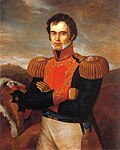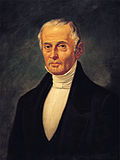First Mexican Republic
The First Mexican Republic, known also as the First Federal Republic (Spanish: Primera República Federal), was a federated republic, established by the Constitution of 1824, the first constitution of independent Mexico. It was officially named the United Mexican States (Spanish: Estados Unidos Mexicanos, ![]() listen (info • help)).[1][2][3] The First Mexican Republic lasted from 1824 to 1835, when conservatives under Antonio López de Santa Anna changed it into a unitary state, the Centralist Republic of Mexico.
listen (info • help)).[1][2][3] The First Mexican Republic lasted from 1824 to 1835, when conservatives under Antonio López de Santa Anna changed it into a unitary state, the Centralist Republic of Mexico.
United Mexican States Estados Unidos Mexicanos | |||||||||
|---|---|---|---|---|---|---|---|---|---|
| 1824–1835 | |||||||||
| Motto: | |||||||||
 Mexico in 1830 | |||||||||
| Capital | Mexico City | ||||||||
| Common languages | Spanish (official), Nahuatl, Yucatec Maya, Mixtecan languages, Zapotec languages | ||||||||
| Religion | Roman Catholicism (official religion) | ||||||||
| Government | Federal presidential republic | ||||||||
| President | |||||||||
• 1824–1829 | Guadalupe Victoria (first) | ||||||||
• 1835 | Miguel Barragán (last) | ||||||||
| Vice President | |||||||||
• 1824–1827 | Nicolás Bravo | ||||||||
• 1829–1832 | Anastasio Bustamante | ||||||||
• 1833–1835 | Valentín Gómez Farías | ||||||||
| Legislature | Congress | ||||||||
| Senate | |||||||||
| Chamber of Deputies | |||||||||
| History | |||||||||
• | 1 November 1824 | ||||||||
| 4 October 1824 | |||||||||
• | 23 October 1835 | ||||||||
| Population | |||||||||
• 1824[4] | 6,500,000 | ||||||||
• 1834[4] | 7,734,292 | ||||||||
| Currency | Mexican real | ||||||||
| ISO 3166 code | MX | ||||||||
| |||||||||
| Today part of | Mexico United States | ||||||||
The republic was announced on November 1, 1823[5] by the Supreme Executive Power, months after the fall of the Mexican Empire ruled emperor Agustin I, a former royalist military officer-turned-insurgent for independence. The federation was formally and legally established on October 4, 1824, when the Federal Constitution of the United Mexican States came into force.[6]
The First Republic was badly harmed and bothered through its whole twelve-year existence by extreme financial and by not having a steady, trustworthy goverment. Political controversies, ever since the drafting of the constitution tended to center around whether Mexico should be a federal or a centralist state, with wider liberal and conservative causes attaching themselves to each group of people involved in a battle respectively. With the exception of the inaugural office holder, Guadalupe Victoria, every single administration (management) during the First Republic was permanently ended by military coup d'état.
The First Republic would finally collapse after the permanent end of the liberal president Valentín Gómez Farías, through a rebellion led by his former vice-president, General Antonio López de Santa Anna who had switched sides. Once in power, the conservatives, who had long been critical of the federal system and blamed it for the nation's instability, repealed the Constitution of 1824 on October 23, 1835, and the Federal Republic became a unitary state, the Centralist Republic. The unitary regime was formally established on December 30, 1836, with the doing of the seven constitutional laws.[7]
Background
Independence
First Mexican Republic Media
Lucas Alamán, leading minister during the First Republic who also placed an emphasis on developing the young republic's educational system
The Spanish Empire fell apart after Napoleon's invasion of Spain and the permanent end of the Spanish Bourbons in 1808. Throughout Spain and her colonies there was a widespread refusal to recognize Napoleon's brother Joseph II as the new French-backed king of Spain. The cleric Miguel Hidalgo y Costilla, who had long been part of a circle of smart people who tried to reform the colonial system triggered the Mexican War of Independence in 1810 by accusing the Spanish ruling classes of seeking to recognize Joseph Bonaparte, while announcing loyalty to the imprisoned Ferdinand VII. The subsequent uprising would go on to seriously threaten the capital yet it was ultimately defeated within a year and Hidalgo was captured and executed.
The war would continue and be organized under Jose Maria Morelos who would gain control over much of southern New Spain. At the Congress of Chilpancingo in 1813 he rejected loyalty to Ferdinand and explained a plan for an independent, Republican Mexico. The Constitution of Apatzingán was approved on October 22, 1814, but it would never come into effect. The tide of war began to turn against the insurgents, and Morelos was captured and executed in 1815.
Meanwhile, in Spain, the Spanish government in exile, the liberal ruled Cortes of Cádiz had included representatives from the colonies, and taken into account many of the colonial complaints which were leading to independence. The resulting liberal Constitution of 1812, was announced and taught during the Morelos insurgency. It established a system of ‘provincial group of representatives’ which granted more autonomy to local governments in the colonies while also providing for freedom of speech. The newly freed Mexican press however simply made worse anti-Spanish feeling, Morelos' rebellion continued, and on the fake reason of need for controlling the rebels, the constitution was suspended in New Spain the same year it was announced, making Mexican liberals lose hope of reaching reform within the colonial system, while not forgetting the local provincial independence that they had temporarily been granted.
Independence was finally gained in 1821 under Agustín de Iturbide's Plan of Iguala which was a conservative reaction against the outbreak of the Trienio Liberal in Spain, but also an agreement with those Mexican liberals who searched for equality before the law. Mexico was to have its independence under a commonwealth system with constitutional monarchy maintaining ties to Spain and government workers in charge were sent to Spain to offer the throne to a Spanish prince. The Spanish government refused the offer and a popular demonstration led to Iturbide himself assuming the throne. The Emperor immediately however began to disagree with the government and showed himself determined to have supreme authority over the government, even shutting congress down and replacing it with a body of loyalists. Iturbide struggled to pay the army, and eventually Santa Anna said in favor of a Federal Republic in his Plan of Casa Mata. After being unable to hold back the rebellion Iturbide met again congress and offered his giving up after which he was permanently removed from the nation. He would attempt to return the following year while Mexico was under a temporary government only to be captured and executed.
References
- ↑ Romo, Rafael (November 23, 2012). After nearly 200 years, Mexico may make the name official. http://www.cnn.com/2012/11/22/world/americas/mexico-name-change/index.html?hpt=hp_t3.
- ↑ "About Mexico". Embajada de Mexico en Estados Unidos (Mexican Embassy in the United States). December 3, 2012. Archived from the original on December 2, 2013. Retrieved July 17, 2013.
- ↑ "Official name of the country". Presidency of Mexico. March 31, 2005. Retrieved May 30, 2010.
- ↑ 4.0 4.1 Evolución de la Población de México durante los años de 1521 al 2000
- ↑ "Acta Constitutiva de la Nación Mexicana". 500 años de México en documentos. Retrieved January 24, 2016.
- ↑ "Decreto. Constitución federal de los Estados-Unidos Mexicanos". 500 años de México en documentos. Retrieved January 22, 2015.
- ↑ "Se transita del federalismo al centralismo mediante las Bases de Reorganización de la Nación Mexicana". 500 años de México en documentos. Retrieved January 24, 2016.









